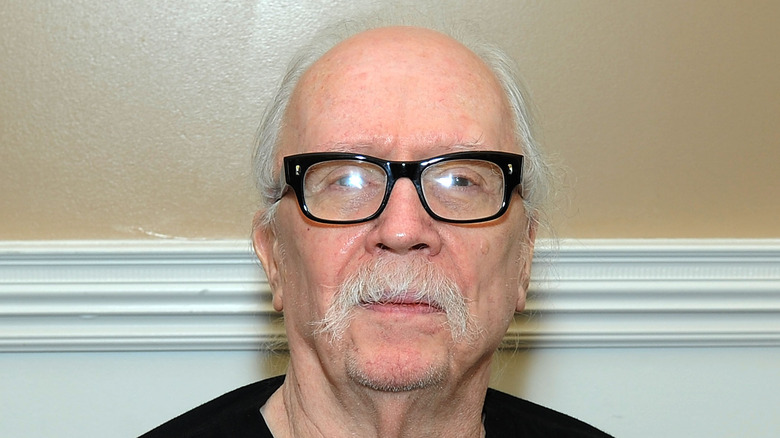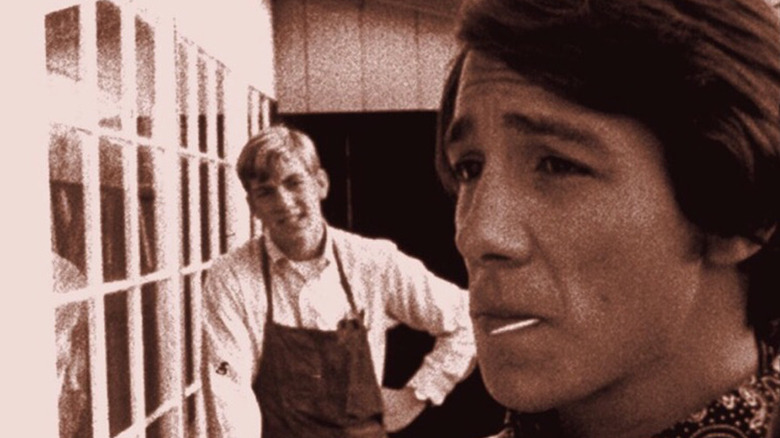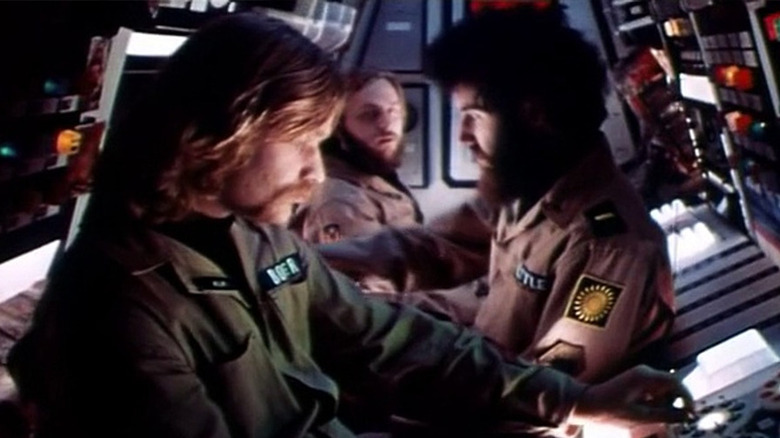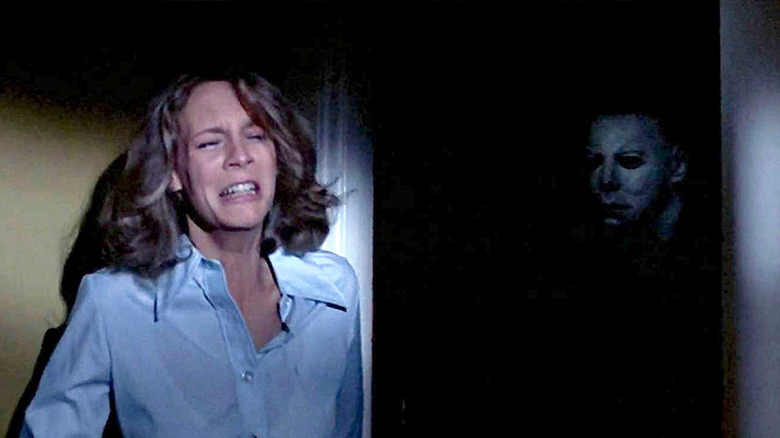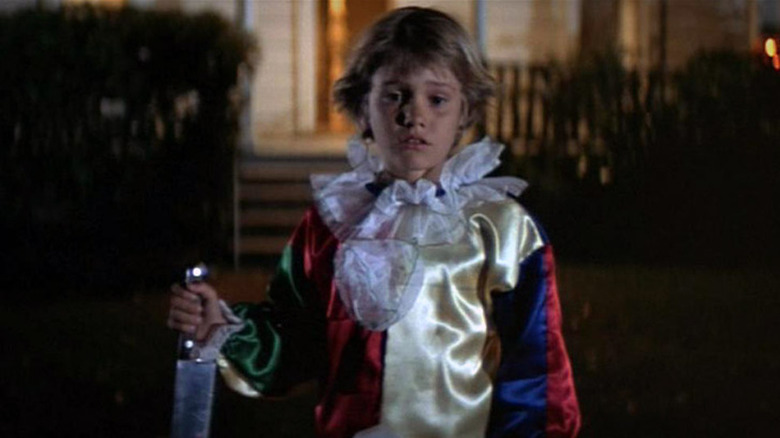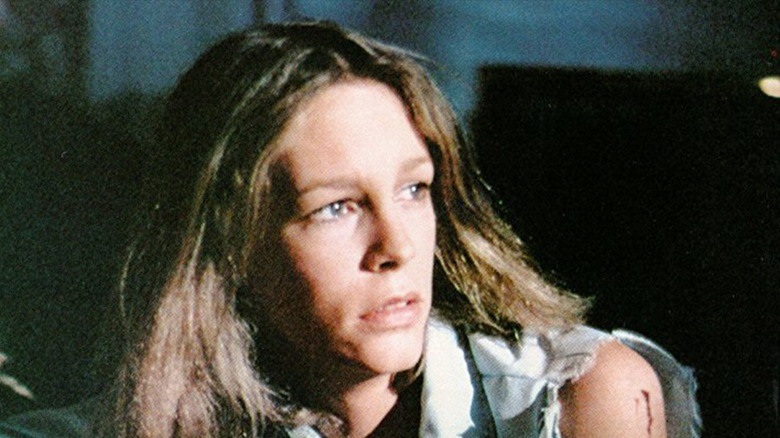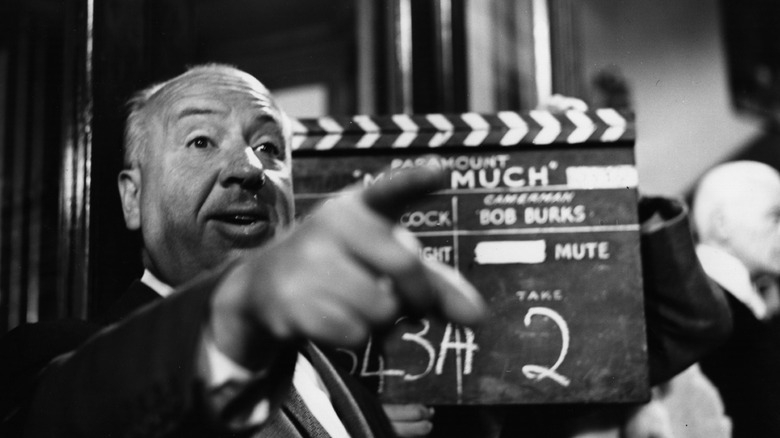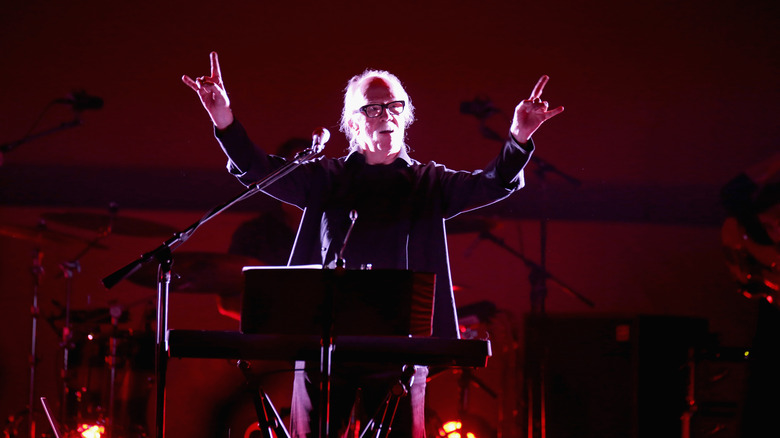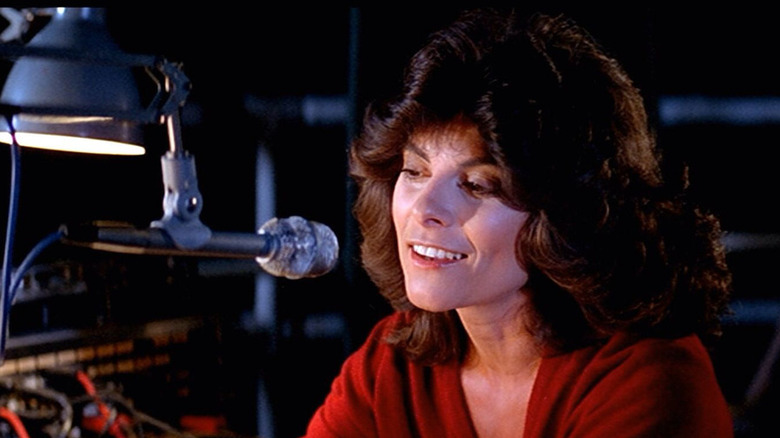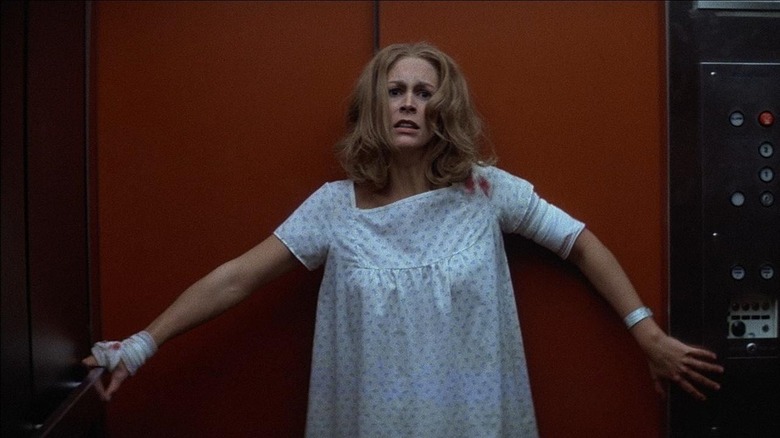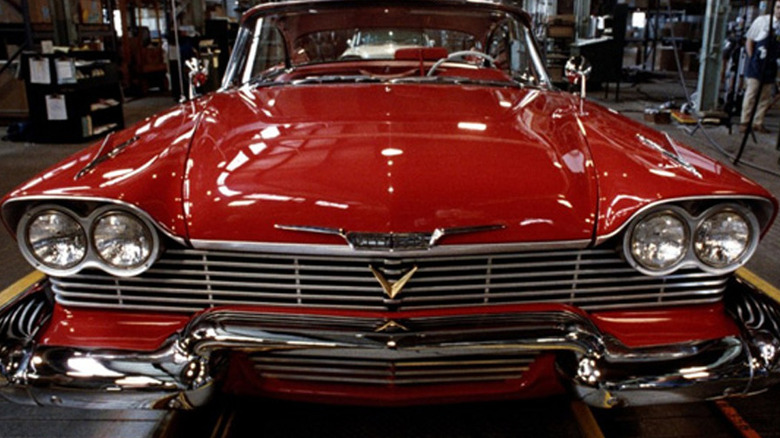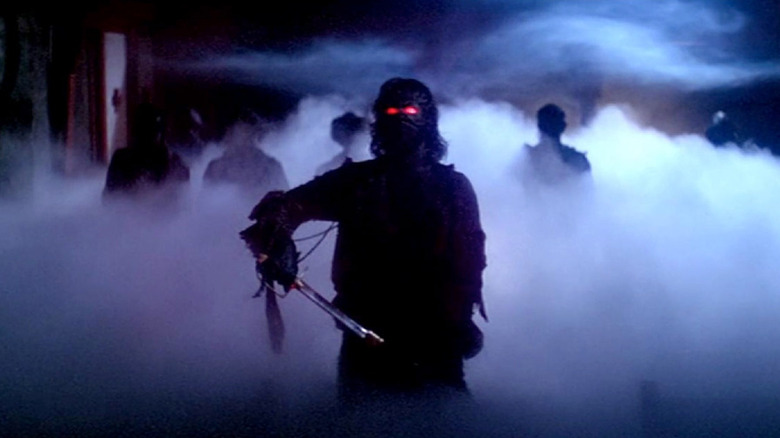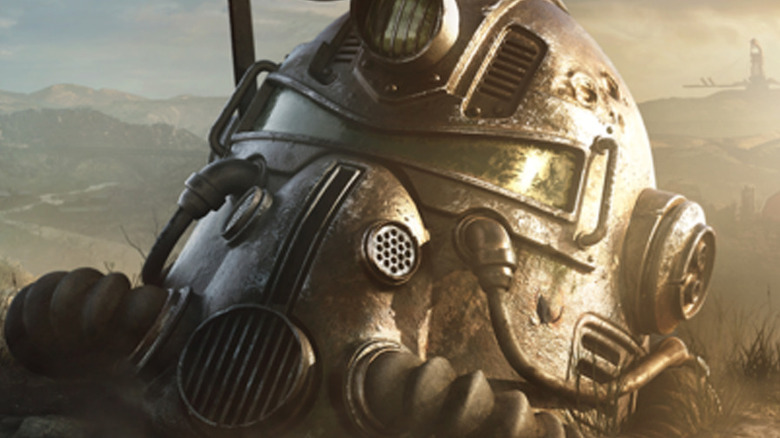The Untold Truth Of John Carpenter
Very few directors have as many memorable films and highly regarded classics under their belt as John Carpenter does. For decades now, the man's name has been synonymous with the horror, action and science fiction genres. Many might know him mainly for revolutionizing horror with his 1978 classic "Halloween" which sparked the 1980s slasher movie trend. But Carpenter's cinematic accomplishments go much deeper than that. He was also at the helm of several cult classics, such as "The Thing" and "Big Trouble in Little China."
All of Carpenter's passion projects ooze personality from every frame — and especially from their musical scores, which he also composes. His signature musical style, in addition to his directorial work, is what Carpenter is best known for, even today. At this point, he has nothing left to prove, content to enjoy life and create art with his family. But there are a few facts concerning the legendary director that you just might not be aware of.
He's won an Oscar ... kind of
John Carpenter has never fully received public acknowledgment for his only Oscar win. While he was a student at USC in the early '70s, he helped create the student film "The Resurrection of Broncho Billy," a western short starring Johnny Crawford in the lead role. Carpenter's duties on the film included co-writing the screenplay, composing the music, and editing the final product.
The short was so well received that the following year it took home the Oscar for Best Short Subject. Due to the fact that he was a student, Carpenter's individual contributions went unrecognized, with the school as a whole receiving the award. "Broncho Billy," followed by Carpenter's full-length debut "Dark Star," served as early proving grounds for the young filmmaker, offering formative experiences and allowing Carpenter to cut his teeth editing various sequences and composing the music. The latter especially would prove to be a key staple of his process as he embarked on his career.
His first feature started as a student film
Carpenter's beginnings as a filmmaker were certainly ambitious and showed, even early on, his cinematic ambitions were huge. "Dark Star" began as a micro-budget student film while Carpenter was a student at the University of Southern California. Along for the ride on this formative filmmaking odyssey was young Dan O'Bannon, a future legend in his own right. Together the duo crafted a 45-minute short sci-fi comedy on a budget of only $6,000. A year after the short's completion, producer Jack H. Harris aided them in turning it into a feature film.
The result, heavily influenced by its student film roots, is a surreal and offbeat affair, definitely appropriate for the decade. Despite their lofty ambitions, "Dark Star" imploded at the box office, its comedic intent largely lost on audiences. However, all was not lost — it developed a solid cult following after its later release on home media. Bannon would go onto bigger movies, such as Ridley Scott's "Alien" and his own "Return of the Living Dead." As for Carpenter? His cinematic ambitions were far from tapped out — he'd soon set out on his next venture, the project which would eventually become the 1976 action-thriller classic known as "Assault on Precinct 13."
He wrote the screenplay for Halloween in 10 days
"Halloween" has so much prestige in the horror genre, you'd think its origins might've been laborious — but as detailed in the 2003 documentary "Halloween: A Cut Above the Rest," it came together relatively quickly and easily. Its roots began with producer Irwin Yablans, who conceived of the film's logline premise while on a flight back from Milan. Having just seen "Assault on Precinct 13," Yablans and financier Moustapha Akkad approached Carpenter with a simple pitch for a film about a killer who stalked and murdered babysitters in a small town on Halloween night. Carpenter agreed in exchange for complete creative control.
The duo agreed to his terms and Carpenter, with Debra Hill in tow, got behind the typewriter and began writing. En route to completion they decided to change the title from "The Babysitter Murders" to the simple "Halloween." Ten days later the duo delivered a screenplay introducing Michael Myers and detailing his chilling inaugural Halloween night rampage.
He was influenced by real-life experiences
Often, the greatest influences on art are major world events and the personal experiences of the artist. When it comes to the horror genre, that notion definitely rings true, including some of its most noteworthy films. "The Amityville Horror" was inspired by extremely grisly real-life events, as was "A Nightmare on Elm Street." Most relevant here, however, are the very specific personal experiences that Carpenter wove into "Halloween." His various inspirations are elaborated on within the 2003 documentary "Halloween: A Cut Above the Rest."
In the documentary, Carpenter talks about his small-town inspirations for the film, as well as the origins of Michael Myers' evil, explaining that "Most small towns have a kind of haunted house story of one kind or another ... At least that's what teenagers believe." When explaining the origins of the evil within Michael Myers, he recounted a college visit to a Kentucky psychiatric facility, where he observed a teenage boy with what he deemed a "schizophrenic stare." That insensitive remark aside, Carpenter's recollections help highlight how even the briefest of interactions can help inspire classic art.
He launched the career of Jamie Lee Curtis
The first "Halloween" is a landmark film for many reasons, not the least of which is the way it popularized the slasher. Its biggest cultural contribution, however, is easily Carpenter's casting of Jamie Lee Curtis, making her film debut. Nowadays Curtis is regarded as one of Hollywood's finest, having received several awards including two Golden Globes and a BAFTA. But before starring in the likes of "Trading Places" and "True Lies," she was just another young actor.
Curtis' mother, Janet Leigh, was already established — particularly in the horror genre because of her starring role in "Psycho." This fact was not lost on Carpenter who, signed her on for the film after seeing she'd auditioned. Through her performance in "Halloween" as well as subsequent horror roles, Curtis would gain the moniker of "Scream Queen." Despite moving onto bigger roles and grander projects Curtis would never forget her roots as Laurie Strode, coming back to reprise the role in several sequels as well as the rebooted franchise that started with the 2018 "Halloween." Years later, Curtis still credits Carpenter for being the one to get the ball rolling on her acting career.
He's been compared to Alfred Hitchcock
It's one thing to pay tribute to your inspirations — to then be praised alongside them is a definite accomplishment. John Carpenter has spoken about his affinity for Alfred Hitchcock and his work on many occasions, including citing Hitchcock's "Vertigo" as one of his favorite films in a Far Out magazine interview. He describes the film as a "perfect nightmare" and "dark and obsessive," both of which are applicable to Carpenter's work as well. Films like "Halloween" and "Precinct 13" depend on the effective nature of the suspense, which both films showcase expertly.
Both directors are often mentioned within the same breath, and it's not without very good reason. In their own ways, Carpenter and Hitchcock both revolutionized horror in separate but equally impressive ways. Hitchcock forever changed the genre with a string of classic scary and suspenseful films — and Carpenter took the slasher into the mainstream, kicking off a streak of masked maniacs on the silver screen.
He has a family band
John Carpenter movies are often known for their stellar soundtracks, many of which are composed and performed by Carpenter himself. Music is such a defining aspect of his creativity that it's remained a passion even after he's largely retired from filmmaking. To this day Carpenter still makes music for fun and profit, and he's made it a family affair — he's joined by his son Cody and his godson Daniel Davies, who's the son of the Kinks' Dave Davies. The Carpenters' band carries forward the legacy of stylized synthesizer music made popular in Carpenter films like "Halloween" and "The Fog." In addition to Carpenter's film scores, the group's shows include a sampling of new material as well.
"This is much more fun than the movies," Carpenter claimed in an interview with the Chicago Tribune. "I get immediate feedback from the audience. Filmmaking is a lot of stress. If you take your job seriously, you're trying to please everybody, which you can't do. In the end, you just have to do the best you can, but the stress is unbelievable. But now, playing music is sensational. I get to have another career in my life for a little while. I hope it keeps up. I'm having a great time."
He was married to Adrienne Barbeau
John Carpenter hasn't just directed a handful of classic horror movies — he also married Adrienne Barbeau, one of the genre's most beloved stars. In a 1980 interview with Barbeau, the actor recalled meeting Carpenter after auditioning for a role in his made-for-television horror film "Someone Is Watching Me," made shortly before he dove into production for "Halloween."
The duo clearly had chemistry right away, but to their credit, they remained professional throughout shooting. After production wrapped, Carpenter approached Barbeau and invited her to the dinner which would officially kick off their romance. The two were married the following year — which was also when, due to "Halloween," Carpenter's career exploded. Barbeau would appear in a few more of Carpenter's films, including "The Fog" and "Escape from New York," but their marriage wasn't meant to last — by the end of the decade, their union had ended in divorce.
Coming up with that Halloween II twist
To quote Homer Simpson: "Alcohol, the cause of, and solution to, all of life's problems." This was most certainly the case for John Carpenter when he sat down to write "Halloween II."
To say that the first "Halloween" was a surprise hit would be a gross understatement. Grossing close to $70 million against its $325,000 budget, it soon prompted demands for a sequel, something Carpenter was very much against. He was quite adamant that the first film's finale was supposed to be an ending, and argued that the movie didn't need a followup.
He was eventually convinced to take on the project anyway, but the process proved to be draining enough to invoke the consumption of many alcoholic beverages while writing. It was under this influence that Carpenter made the (since retconned) decision to make Michael Myers and Laurie Strode siblings — something he's since derided as "a terrible, stupid idea." Carpenter's liquor-fueled plot twist was parodied years later in a Budweiser commercial that aired in 2019.
He made Christine out of necessity
It's always important to remember that filmmaking is still a job, and sadly not everything is a passion project. John Carpenter, much like the rest of us, has bills to pay, and he's taken several jobs for the money. His most noteworthy stint as a director for hire came when he directed an adaptation of Stephen King's "Christine" out of monetary necessity.
Carpenter talked a lot about the project during an interview with SFX magazine, admitting the cynical mindset behind that decision and recalling how at the time he was approached to direct, his most recent film, "The Thing," had underperformed commercially. He needed work, and felt like he needed it as soon as possible. Saying he wasn't scared by the book and admitting the project wasn't one of actual passion for him, he shrugged, "It was something I needed to do at that time for my career."
He's scored most of his films on his own
John Carpenter's stellar scores serve to help cement his films' distinct tones, and he's been behind the bulk of the music featured throughout his filmography. Carpenter's music relies heavily on the usage of low, ominous synthesizer tones and rhythms, and his hands-on approach has led to some of cinema's most memorable music.
There is, of course, the sinister simplicity of the original 1978 "Halloween" theme, which has resurfaced throughout the franchise. Additionally, there are the appropriately ghostly melodies used to consistently haunting effect throughout his 1980 release "The Fog," and one can't forget the rhythmic earworm used in the opening titles for "Big Trouble in Little China." (The latter of those examples came in part from Alan Howarth, a talented composer Carpenter collaborated with frequently.) Even if you haven't seen his movies in full, there's a good chance you've heard their music.
He's an avid gamer
When your day job consists of imagining suburban murder and otherworldly horror stories, what do you do in your downtime? For John Carpenter, the answer to that question is often "play video games."
Carpenter has been an avid video game enthusiast since playing "Sonic the Hedgehog" in the '90s with his son. More recently, he's used his Twitter account to offer his gaming opinions, telling followers that his go-to options when killing time are the "Borderlands" games created by Gearbox Software. Additionally, he's noted that he loves first-person shooters, preferring them over games with single-player narratives.
It's also worth noting that Carpenter has some game-related hot takes you might not expect, including his legitimate affinity for the critically panned "Fallout 76" released by Bethesda. Video games and movies have gotten closer than ever in terms of their narrative capabilities in recent years — it makes perfect sense that gaming would appeal to a gifted filmmaker like Carpenter.
